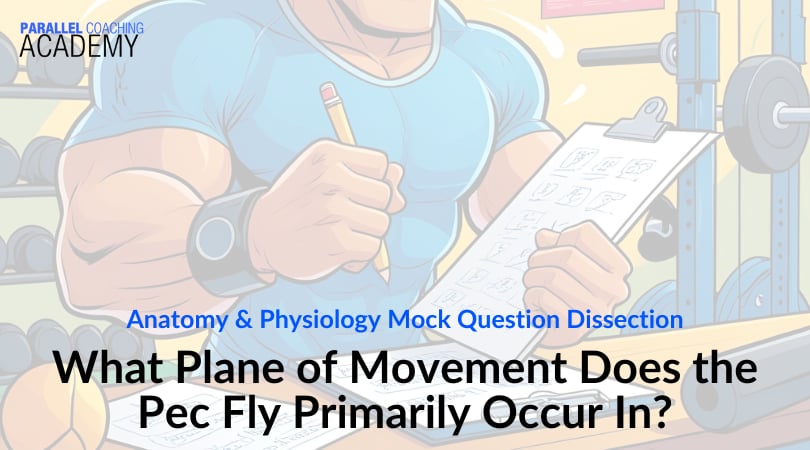Mock question practice is an excellent way to test your knowledge of anatomy and physiology, but the real benefit comes from dissecting them properly. Understanding why the correct answer is correct and why the others are not. Below is a level 2 anatomy and physiology mock question. This mock question will not appear in any live exam. Let’s break down this sample question and understand the answer below.
Mock Question: What plane of movement does the pec fly primarily occur in?
Options:
A. Transverse
B. Sagittal
C. Frontal
D. Medial-Lateral
1. How to Read the Question and Answers Properly
Before jumping to an answer, identify key terms and verbs. Here, the key terms are “plane of movement” and “pec fly”. Notice the verb “does occur”, which asks for the primary plane, not secondary or assisting movements. Read each answer carefully and mentally compare it to the exercise in question.
You have plenty of time in your live anatomy and physiology exam to read the question and fully understand what is being asked. Seach for Key terms and the verb. Verbs could include: Identify / Name / State / Describes / Apply / Connect / Support.
Let’s dissect the above mock question.
2. Understanding the Transverse Plane: Let’s explore option A.
The transverse plane divides the body into top and bottom halves. Movements in this plane occur horizontally, like rotating or bringing limbs together across the body.
Exercises that involve horizontal adduction, such as the pec fly, occur in this plane.
3. Eliminating Other Planes
- Sagittal plane: Divides the body into left and right; movements are forward/back (e.g., bicep curl). Not correct for pec fly.
- Frontal plane: Divides the body into front and back; side-to-side movements occur here (e.g., lateral raises). Not correct.
- Medial-lateral: This is a directional term, not a plane of movement — careful not to confuse anatomical jargon.
4. Pec Fly Mechanics
The pec fly primarily involves horizontal shoulder adduction, bringing the arms together in front of the body. Understanding the joint movements of an exercise is essential for connecting anatomy, physiology, and movement planes.
5. Mock Questions are a Tool, Not the Only Strategy
Mock questions are useful for testing recall and identifying weak areas, but they are not live exam questions. Relying on them exclusively may lead to memorising answers rather than truly understanding concepts.
Combining mock questions with revision tutorials, anatomy diagrams, and applied practice ensures deeper knowledge and exam readiness.
6. Correct Answer Explained:
A. Transverse Plane ✅
The pec fly occurs in the transverse plane because the arms move horizontally across the chest (horizontal adduction at the shoulder joint).
Both pectoralis major and minor muscles are primarily responsible for this movement. The transverse plane allows this horizontal motion, unlike the sagittal (forward/back) or frontal (side-to-side) planes. Recognising the plane helps you accurately apply anatomy and biomechanics knowledge in both exams and client programming.
Summary
Dissecting a mock question properly develops your ability to read, analyse, and apply anatomy and physiology knowledge.
Focus on identifying key terms, understanding the relevant plane, knowing exercise mechanics, and using mock questions as a learning tool, not a crutch. Knowing the correct answer and why it’s correct ensures confidence and prepares you for any variation of questions on your exam.
More importantly, understanding how anatomy and physiology applies to real-world training helps you plan and deliver sessions safely and effectively. It also allows you to educate clients, provide accurate feedback, and grow as a confident fitness professional.
Many trainee fitness professionals struggle with learning anatomy and physiology… especially planes of movement. With so much to cover for the exam, knowing where to start and what to focus on can feel overwhelming.
Parallel Coaching’s Revision Bootcamps provide a clear 5-step system with everything you need: a done-for-you revision schedule, topic-specific tutorials, cheat sheets, and unseen mock questions. You get instant and lifetime access, and over 10,000 learners have already used the bootcamps to pass their fitness anatomy and physiology exams with confidence.
Click here to find out more about our Revision Bootcamps
https://courses.parallelcoaching.co.uk/products/revision-bootcamps
If you enjoyed this blog, check out more similar blogs here:
- Mock question dissection: https://parallelcoaching.co.uk/the-sagittal-plane-what-axis-of-movement
- What Is The Difference Between Planes of Movement and Axis of Movement: https://parallelcoaching.co.uk/what-is-the-difference-between-planes-of-movement-and-axis-of-movement
Dedicated to More
Parallel Coaching
P.S. You can also find us on the following platforms:
- Instagram: Follow Now
- Facebook: Like Our Page
- Twitter: Tweet Us
- YouTube: Subscribe Here
- More Anatomy Revision Blogs: HERE
- Listen on iTunes: FitPro Sessions
- Download on Spotify: FitPro Sessions
Sources
- American Council on Exercise (ACE). Planes of Movement in Exercise.
- NASM Essentials of Exercise Science. Exercise Biomechanics and Movement Analysis.
- British Journal of Sports Medicine (2020). Effective learning strategies for anatomy and physiology.

